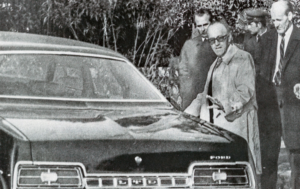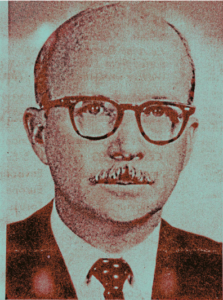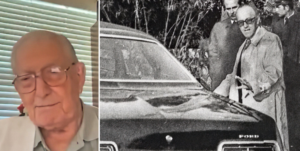It is the winter of 1958, a very cold night in Kavala, with people locked in their homes, when Ron Estes returns to his own after midnight. At that time he is a young and very capable CIA operational agent in Greece, operating in the wider region without being covered by diplomatic status.
Sometimes he travels to Thessaloniki to inform the CIA station in Athens about his activities from the US consulate and returns to Kavala.
When he is transferred to the Service station housed inside the US embassy building in 1973, he cannot imagine that 65 years later, in the twilight of his life, the murder of Welch will still be following him.
Speaking to journalist James Risen, author of the book “The last honest man”, Estes clearly states that the Greek National Intelligence Service (KYP) leaked the status of Richard Welch as the CIA station chief in Athens to the English-language newspaper “Athens News” and in “Freedom” in November 1975.

In the book, in an interview he gave last August on YouTube, but also a few days ago on the website The Intercept, which specializes in issues related to the security services, the former CIA staff member reveals unknown aspects of the case that marked the appearance of 17N. Among them is a meeting he had with the then deputy commander of the KYP, shortly before the Wells murder, where the Greek official asked if relations between the two agencies were harmonious.
He had found together with the then commander Konstantinos Fetsis that the Americans were no longer so cooperative. Estes responded diplomatically, keeping to himself that the leak of the status of Welch and other Americans working at the embassy in Athens could only be done by the KYP.
To the question of why this should be the case, the answer for Estes is simple, since all the names of Americans who were leaked and made public only had contact with officials of KYP.
Ioannidis and the revenge for Cyprus
Ron Estes is considered one of the CIA’s most capable agents and held senior staff positions until his retirement. Until recently little was known about his actions, since he had never spoken, especially about the murder of Welch .
After the 16 months in Kavala, he served at the CIA station in Athens for three years, since he spoke the Greek language perfectly, and completed his first tour in Greece in 1960-61.
This was followed by his transfer to Cyprus, the island where he met Richard Welch, who also spoke Greek. There a strong friendship was built between the two men. As Estes told Risen, it didn’t take long for Richard to reveal to him that he had recruited Macarius’ secretary to spy for the CIA.

Tensions between Cypriots and Turkish Cypriots were rising after the liberation of the island from the British and in December 1963 the riots that broke out in Nicosia were violent.
The American citizens left the island, but Estes remained at the CIA station in Nicosia, inside the bombed-out embassy, to coordinate the action of CIA agents. He was lost with Welch for the next ten years, taking transfers to countries of great interest to the US, and in 1970 he served in Beirut for three years.
He never forgot the day he was told he was returning to Athens in 1973 as deputy station chief, and almost two years later Richard Welch was being transferred to the capital as CIA station chief.
After the Turkish invasion of Cyprus, US-Greek relations are at their lowest, which is also the case with the secret services of the two countries. The junta falls, but some of the KYP, according to Estes, want to take revenge on the Americans for the US betrayal of Cyprus and so they give names of agents of the CIA station in Athens, according to what Estes said in the book and also in the interview which he granted to the Intercept.
The murder and the report
Paleo Psychiko at night is usually a quiet suburb, especially in winter, since the residents are locked in their houses early. Which was not the case with three people waiting inside a green Simca that December night 48 years ago.
It was Tuesday, December 23, late at night, on a street in the aristocratic suburb dominated by the villa traditionally occupied by the current CIA station chief, for whom the trio was waiting a few meters away from the entrance of his residence.
Their target was Richard Welch. In a Greece where the Republic had just been restored and was trying to recover from the seven years of the colonels and the invasion of Cyprus, the three men chose an impressive strike.
One of them was clutching a .45 Colt, loaded and thoroughly checked so that nothing would happen when he pulled the trigger.
Welch had gone with his second wife Kika to a Christmas call by the American ambassador and although he had noticed that people had been watching him lately, he was not worried. He thought they might be KGB agents, but of course he was wrong. The moment the limousine he was riding in arrived at the entrance of his residence, the three got out of the car and quickened their pace.
It was about ten o’clock, they were all wearing hoods, and as they neared their goal, two of them removed Welch’s wife and driver, while the third told him to put his hands up.
The execution
When Welch replied “What?” in English, the gunman shot the CIA station chief three times, who fell dead instantly after one bullet hit the heart’s aorta, the body’s first and dominant artery.
The legendary in the years that followed, the .45 Colt of 17N, the one that has not been found to this day – just as the executioner of the American station master has not been found – had been fired and the terrorist organization was just beginning its bloody course.
The trio strode away but without running, got into the green Simca and sped off into the streets of Psychiko, just as Mrs. Wells’ screams shattered the stillness of the night.
A few minutes later, the Welch’s driver knocked on the door of the apartment where Ron Estes’ fiancee lived, knowing she was there. They left together and arriving at the scene, Estes knelt down and saw Dick’s face covered in blood, at the same time ascertaining that he was dead.
“I didn’t have to check for a pulse”, he told the Intercept of the night he’ll never forget, of escorting his dead friend to the hospital with the escort of a police car and the press barrage he received. Among them was Stephen Roberts, the New York Times correspondent in Athens, and as Estes discovered, he was not the only one who knew of Welch’s status.
He made sure to leave immediately for the embassy in order to inform Agency headquarters in Langley of the assassination by speaking from a “secure line.” He spoke with a senior CIA official who asked him to immediately send a report on the incident to inform President Gerald Ford.
The next morning Estes informed the agents gathered in Wells’ office of what had happened. A couple started crying, one went to get a gun to kill the KGB station chief in Athens, and from that moment almost all other “business” took a back seat. The Americans’ primary concern was to find Welch’s killer, so the hunt began to collect information from sources in Greece.
No one knew anything about 17N, a fledgling terrorist organization that claimed responsibility for the attack, while the Greek authorities’ investigations were completely misguided and directionless.
After months of investigation Ron Estes compiled a lengthy report on the murder of Richard Welch, in which he pointed out that the leak of the station chief’s information was done by the KYP as a revenge move by Greece for the US policy in Cyprus that measured the wounds of the Turkish invasion.
Ask me anything
Explore related questions





